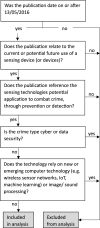A systematic review of sensors to combat crime and routes to further sensor development
- PMID: 40575464
- PMCID: PMC12198248
- DOI: 10.3389/fchem.2025.1568867
A systematic review of sensors to combat crime and routes to further sensor development
Abstract
Forensic science plays an important part in crime reduction but faces many challenges. These include the validity, cost and complexity of current sensors used, and a reliance on trained professionals to conduct analyses. Recent advances in sensor technologies present a promising opportunity for rapid, decentralized, and cost-effective analysis by untrained individuals in the field. To date, a comprehensive systematic review covering sensing technologies and use cases has been lacking. This paper addresses that gap. After the initial screening of papers, 1,482 publications were included in the review, from which data on target analytes and sensing technologies were extracted. Given that law enforcement have limited resources, a second screening examined papers that focused on low-cost sensing devices published from 2020 onwards (N = 791). Overall, our review identified eleven key analyte categories that had been researched: illicit drugs, fingerprints, explosives, body fluids, food safety, poisons and toxins, pollutants, counterfeits and documentation, fire, gunshot, and others. Low-cost sensing technologies identified were categorised into electrochemical, colourimetric, immunoassay, luminescence and SERS. We review trends in the research reported, barriers to commercialisation and adoption, and review the use of these types of sensors by law enforcement agencies. Current sensors used by authorities face challenges of high costs, specificity issues, limited detection capabilities and complex sample preparation. Emerging research focuses on cost-effective printed electrodes and dual detection techniques to enhance analyte sensitivity and detection accuracy. Notably, body fluid analysis plays a crucial role in criminal cases, but current sensors suffer issues like false positives, DNA degradation, and high costs. Studies investigating eco-friendly materials and dual-detection approaches show promise in addressing these issues. Illicit drug analysis constitutes over one-third (36%) of included publications. In the UK, police rely on NIK tests and DrugWipe sensors for on-site drug detection, but challenges related to sensitivity, specificity, and confirmatory testing persist. Ongoing research explores dual detection methods, lateral flow immunoassays, and electro-chemiluminescent screening to enhance specificity and matrix tolerance. Future efforts should prioritise refining dual detection methods, reducing matrix interference, low-cost/eco-friendly materials and fostering collaboration between academia and law enforcement for effective implementation in these areas.
Keywords: body fluid analysis; combating crime; food safety analysis; illicit drug detection; low-cost sensors; point-of-care detection; sensor (or biosensor); systematic review.
Copyright © 2025 Cozens, Johnson and Lee.
Conflict of interest statement
The authors declare that the research was conducted in the absence of any commercial or financial relationships that could be construed as a potential conflict of interest.
Figures





Similar articles
-
Health professionals' experience of teamwork education in acute hospital settings: a systematic review of qualitative literature.JBI Database System Rev Implement Rep. 2016 Apr;14(4):96-137. doi: 10.11124/JBISRIR-2016-1843. JBI Database System Rev Implement Rep. 2016. PMID: 27532314
-
A rapid and systematic review of the clinical effectiveness and cost-effectiveness of paclitaxel, docetaxel, gemcitabine and vinorelbine in non-small-cell lung cancer.Health Technol Assess. 2001;5(32):1-195. doi: 10.3310/hta5320. Health Technol Assess. 2001. PMID: 12065068
-
Rapid molecular tests for tuberculosis and tuberculosis drug resistance: a qualitative evidence synthesis of recipient and provider views.Cochrane Database Syst Rev. 2022 Apr 26;4(4):CD014877. doi: 10.1002/14651858.CD014877.pub2. Cochrane Database Syst Rev. 2022. PMID: 35470432 Free PMC article.
-
Signs and symptoms to determine if a patient presenting in primary care or hospital outpatient settings has COVID-19.Cochrane Database Syst Rev. 2022 May 20;5(5):CD013665. doi: 10.1002/14651858.CD013665.pub3. Cochrane Database Syst Rev. 2022. PMID: 35593186 Free PMC article.
-
Antibody tests for identification of current and past infection with SARS-CoV-2.Cochrane Database Syst Rev. 2022 Nov 17;11(11):CD013652. doi: 10.1002/14651858.CD013652.pub2. Cochrane Database Syst Rev. 2022. PMID: 36394900 Free PMC article.
References
-
- Abdelkader M., Elmanzalawy M., Pauliukaite R. (2022). 3-D electrodes for electrochemical sensors: review in different approaches. IEEE Sens. J. 22 (24), 23620–23632. 10.1109/jsen.2022.3220815 - DOI
-
- Abd-Elsabour M., Alsoghier H. M., Alhamzani A. G., Abou-Krisha M. M., Yousef T. A., Assaf H. F. (2022). A novel electrochemical sensor for detection of nicotine in tobacco products based on graphene oxide nanosheets conjugated with (1,2-naphthoquinone-4-sulphonic acid) modified glassy carbon electrode. Nanomaterials 12 (14), 2354. 10.3390/nano12142354 - DOI - PMC - PubMed
-
- Abdollahi A., Dashti A., Rahmanidoust M., Hanaei N. (2022). Metal-free and ecofriendly photoluminescent nanoparticles for visualization of latent fingerprints, anticounterfeiting, and information encryption. SENSORS ACTUATORS B-CHEMICAL 372, 132649. 10.1016/j.snb.2022.132649 - DOI
-
- Abdulhussein S. K., Al-Kazazz F. F. M., Rheima A. M. (2022). The role of nanomaterials in the recent development of electrochemical biosensors. Port. ELECTROCHIMICA ACTA 41 (3), 211–221. 10.4152/pea.2023410303 - DOI
-
- Abel R. J., Zadora G., Sandercock P. M. L., Harynuk J. J. (2018). Modern instrumental limits of identification of ignitable liquids in forensic fire debris analysis. Separations 5 (4), 58. 10.3390/separations5040058 - DOI
Publication types
LinkOut - more resources
Full Text Sources
Miscellaneous

